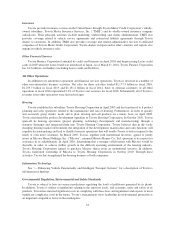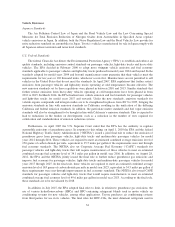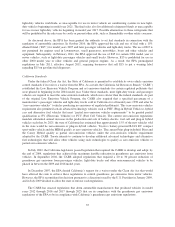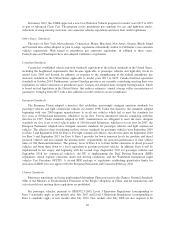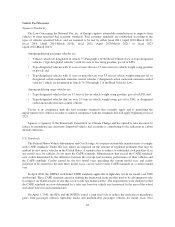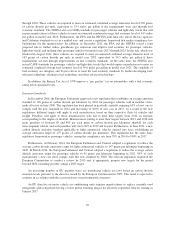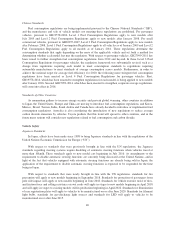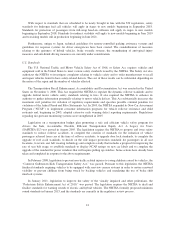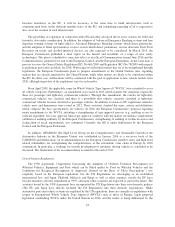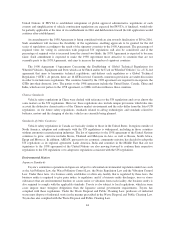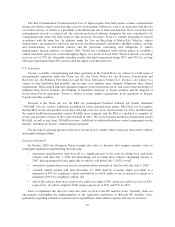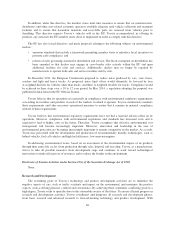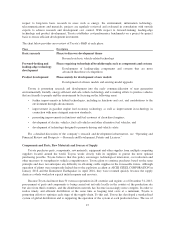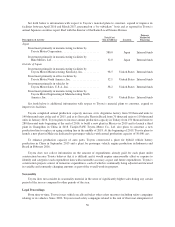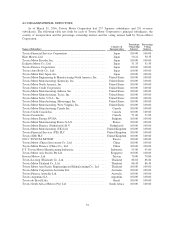Toyota 2015 Annual Report Download - page 48
Download and view the complete annual report
Please find page 48 of the 2015 Toyota annual report below. You can navigate through the pages in the report by either clicking on the pages listed below, or by using the keyword search tool below to find specific information within the annual report.becomes mandatory in the EU, it will be necessary at the same time to build infrastructure such as
communication bases in the different member states of the EU, and rulemaking regarding eCall is expected to
also cover the creation of such infrastructure.
The possibility of regulation in connection with ITS and other advanced driver assist systems for 2020 and
beyond is also under consideration. In addition, the adoption of Advanced Emergency Breaking systems and lane
departure warning systems on light vehicles, Advanced Emergency Breaking systems which detect pedestrians,
and the adoption of blind spot monitors, reverse system which detect pedestrians, reverse detection, Evert Data
Recorders on trucks and alcohol interlock devices are also expected to be considered. In March 2015, the
European Commission published a final report on the benefit and feasibility of a range of new safety
technologies. The plan is scheduled to come into effect as an official Communication around June 2016 and the
Communication is planned to be sent to the European Council and the European Parliament. At the same time, a
process to revise the General Safety Regulation (EC) No 661/2009 and Regulation (EC) No 78/2009 with regards
to pedestrian protection are likely for 2016. With respect to individual matters that are to be strengthened through
regulations, the European Commission plans to propose amendments to the United Nations rules regarding
matters that are already regulated by the United Nations, while other matters are likely to be considered within
the EU. In either case, deliberations will be conducted with the goal of application to new vehicle models from
2020, although target date of the regulations vary for each matter.
From April 2009, the applicable scope for Whole Vehicle Type Approval (“WVTA”) was extended to cover
all vehicle categories. Furthermore, an amendment was issued in 2011 which clarifies the categories (especially
those for passenger and light-duty commercial vehicles). Through this amendment, the criteria for light-duty
commercial vehicles was clarified, and there is a possibility that vehicles currently classified as light-duty
commercial vehicles become classified as passenger vehicles. In addition, revisions to EU regulations related to
vehicle mass and dimensions were issued in 2012. These revisions clarified the mass, criteria and definitions
which comprise the base specifications for vehicles. In 2016, the European Commission’s proposal regarding
major amendments to the WVTA, including a strengthening of type approval process (e.g. enabling access to
software algorithm; five year approval limit (type approval validity)) with the market surveillance requirements
(addition of auditing authority by the European Commission), strengthening of auditing of technical service and
clarification of recall requirements, was submitted. Currently, the bill is under deliberation by the European
Council and the European Parliament.
In addition, GEAR2030 (the High Level Group on the Competitiveness and Sustainable Growth of the
Automotive Industry in the European Union) was established in January 2016 as a successor body of the
CARS2020 and deliberations on recommendations to the European Commission, member states and high-level
related stakeholders for strengthening the competitiveness of the automobile value chain in Europe by 2030
commenced. In particular, a roadmap for smooth development of automatic driving vehicles is scheduled to be
discussed. The finalization of the recommendation is aimed for the end of 2017.
United Nations Regulations
The 1958 Agreement (“Agreement Concerning the Adoption of Uniform Technical Prescriptions for
Wheeled Vehicles, Equipment and Parts which can be Fitted and/or be Used on Wheeled Vehicles and the
Conditions for Reciprocal Recognition of Approvals Granted on the Basis of These Prescriptions”) was
originally based on the European regulations, but the UN Regulations are developing as an established
international law, and Japan, Thailand, Malaysia and Egypt as well as other countries outside the EU have
become members after the amendment in 1995, and many other countries are expected to join in the future. The
countries bound by the 1958 Agreement have incorporated the UN Regulations into their own domestic policies
(The EU and Japan have directly included the UN Regulations into their domestic legislations). While
automotive parts and vehicle systems are regulated by the UN regulations, there are currently no regulations with
respect to International Whole Vehicle Type Approval (IWVTA) such as those in Europe. Japan proposed
legislation establishing WVTA under the United Nations in 2016, and the matter is being deliberated by the
43


